ESP Alfa Romeo 4C 2014 Owner handbook (in English)
[x] Cancel search | Manufacturer: ALFA ROMEO, Model Year: 2014, Model line: 4C, Model: Alfa Romeo 4C 2014Pages: 190, PDF Size: 7.87 MB
Page 46 of 190
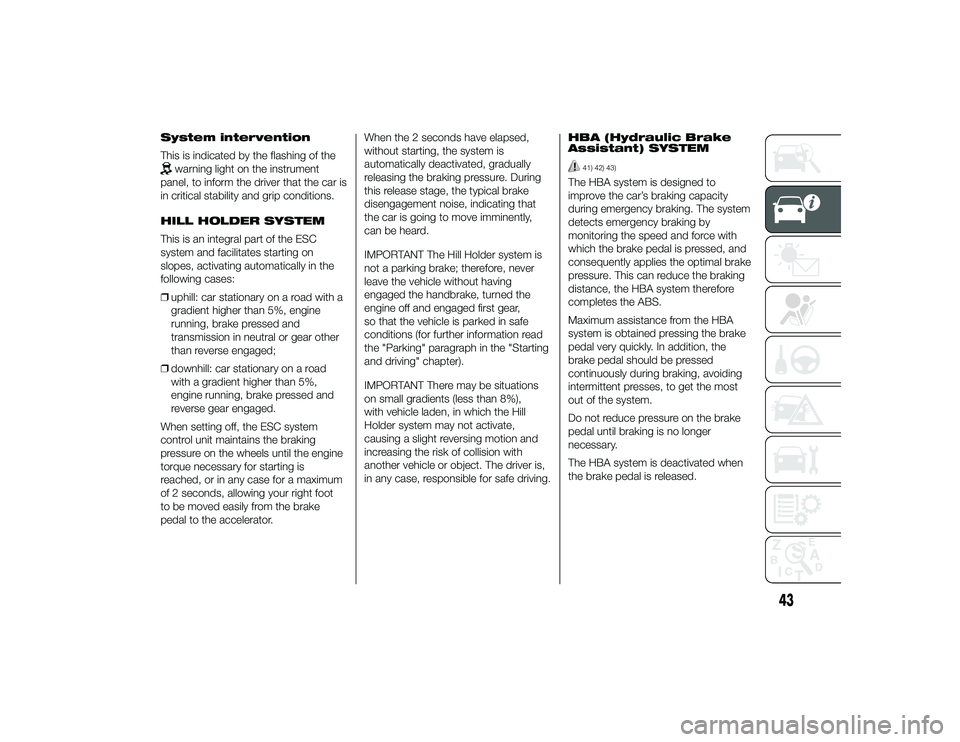
System intervention
This is indicated by the flashing of the
warning light on the instrument
panel, to inform the driver that the car is
in critical stability and grip conditions.
HILL HOLDER SYSTEM
This is an integral part of the ESC
system and facilitates starting on
slopes, activating automatically in the
following cases:
❒ uphill: car stationary on a road with a
gradient higher than 5%, engine
running, brake pressed and
transmission in neutral or gear other
than reverse engaged;
❒ downhill: car stationary on a road
with a gradient higher than 5%,
engine running, brake pressed and
reverse gear engaged.
When setting off, the ESC system
control unit maintains the braking
pressure on the wheels until the engine
torque necessary for starting is
reached, or in any case for a maximum
of 2 seconds, allowing your right foot
to be moved easily from the brake
pedal to the accelerator. When the 2 seconds have elapsed,
without starting, the system is
automatically deactivated, gradually
releasing the braking pressure. During
this release stage, the typical brake
disengagement noise, indicating that
the car is going to move imminently,
can be heard.
IMPORTANT The Hill Holder system is
not a parking brake; therefore, never
leave the vehicle without having
engaged the handbrake, turned the
engine off and engaged first gear,
so that the vehicle is parked in safe
conditions (for further information read
the "Parking" paragraph in the "Starting
and driving" chapter).
IMPORTANT There may be situations
on small gradients (less than 8%),
with vehicle laden, in which the Hill
Holder system may not activate,
causing a slight reversing motion and
increasing the risk of collision with
another vehicle or object. The driver is,
in any case, responsible for safe driving.
HBA (Hydraulic Brake
Assistant) SYSTEM
41) 42) 43)
The HBA system is designed to
improve the car’s braking capacity
during emergency braking. The system
detects emergency braking by
monitoring the speed and force with
which the brake pedal is pressed, and
consequently applies the optimal brake
pressure. This can reduce the braking
distance, the HBA system therefore
completes the ABS.
Maximum assistance from the HBA
system is obtained pressing the brake
pedal very quickly. In addition, the
brake pedal should be pressed
continuously during braking, avoiding
intermittent presses, to get the most
out of the system.
Do not reduce pressure on the brake
pedal until braking is no longer
necessary.
The HBA system is deactivated when
the brake pedal is released.
43
24-9-2013 11:49 Pagina 43
Page 47 of 190
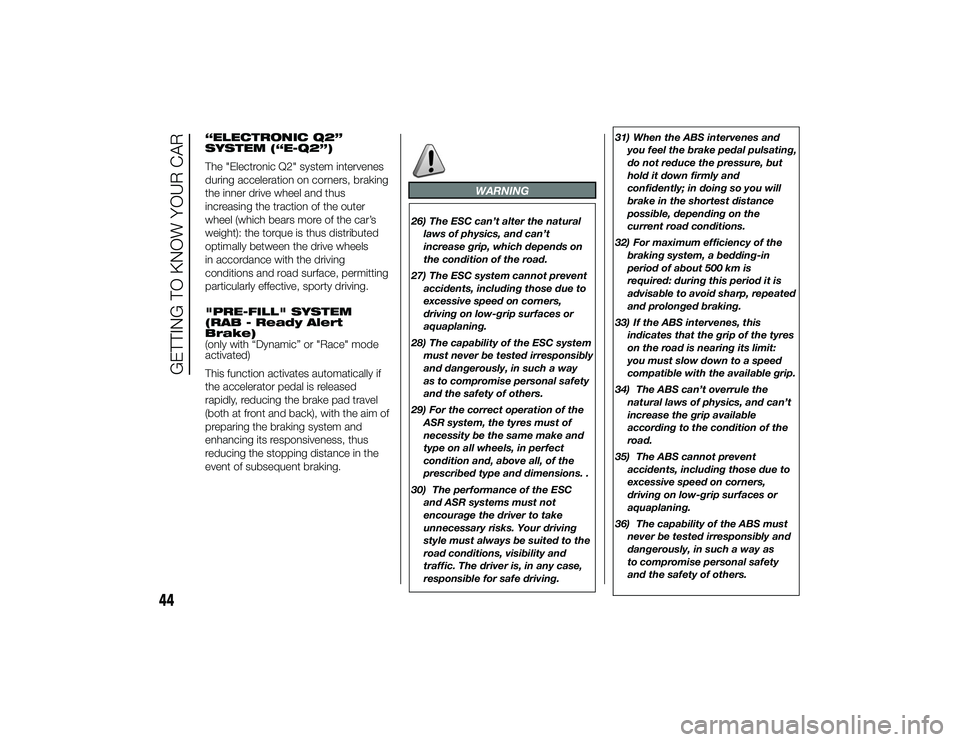
“ELECTRONIC Q2”
SYSTEM (“E-Q2”)
The "Electronic Q2" system intervenes
during acceleration on corners, braking
the inner drive wheel and thus
increasing the traction of the outer
wheel (which bears more of the car’s
weight): the torque is thus distributed
optimally between the drive wheels
in accordance with the driving
conditions and road surface, permitting
particularly effective, sporty driving.
"PRE-FILL" SYSTEM
(RAB - Ready Alert
Brake)
(only with “Dynamic” or "Race" mode
activated)
This function activates automatically if
the accelerator pedal is released
rapidly, reducing the brake pad travel
(both at front and back), with the aim of
preparing the braking system and
enhancing its responsiveness, thus
reducing the stopping distance in the
event of subsequent braking.
WARNING
26) The ESC can’t alter the naturallaws of physics, and can’t
increase grip, which depends on
the condition of the road.
27) The ESC system cannot prevent accidents, including those due to
excessive speed on corners,
driving on low-grip surfaces or
aquaplaning.
28) The capability of the ESC system must never be tested irresponsibly
and dangerously, in such a way
as to compromise personal safety
and the safety of others.
29) For the correct operation of the ASR system, the tyres must of
necessity be the same make and
type on all wheels, in perfect
condition and, above all, of the
prescribed type and dimensions. .
30) The performance of the ESC and ASR systems must not
encourage the driver to take
unnecessary risks. Your driving
style must always be suited to the
road conditions, visibility and
traffic. The driver is, in any case,
responsible for safe driving. 31) When the ABS intervenes and
you feel the brake pedal pulsating,
do not reduce the pressure, but
hold it down firmly and
confidently; in doing so you will
brake in the shortest distance
possible, depending on the
current road conditions.
32) For maximum efficiency of the braking system, a bedding-in
period of about 500 km is
required: during this period it is
advisable to avoid sharp, repeated
and prolonged braking.
33) If the ABS intervenes, this indicates that the grip of the tyres
on the road is nearing its limit:
you must slow down to a speed
compatible with the available grip.
34) The ABS can’t overrule the natural laws of physics, and can’t
increase the grip available
according to the condition of the
road.
35) The ABS cannot prevent accidents, including those due to
excessive speed on corners,
driving on low-grip surfaces or
aquaplaning.
36) The capability of the ABS must never be tested irresponsibly and
dangerously, in such a way as
to compromise personal safety
and the safety of others.
44
GETTING TO KNOW YOUR CAR
24-9-2013 11:49 Pagina 44
Page 48 of 190
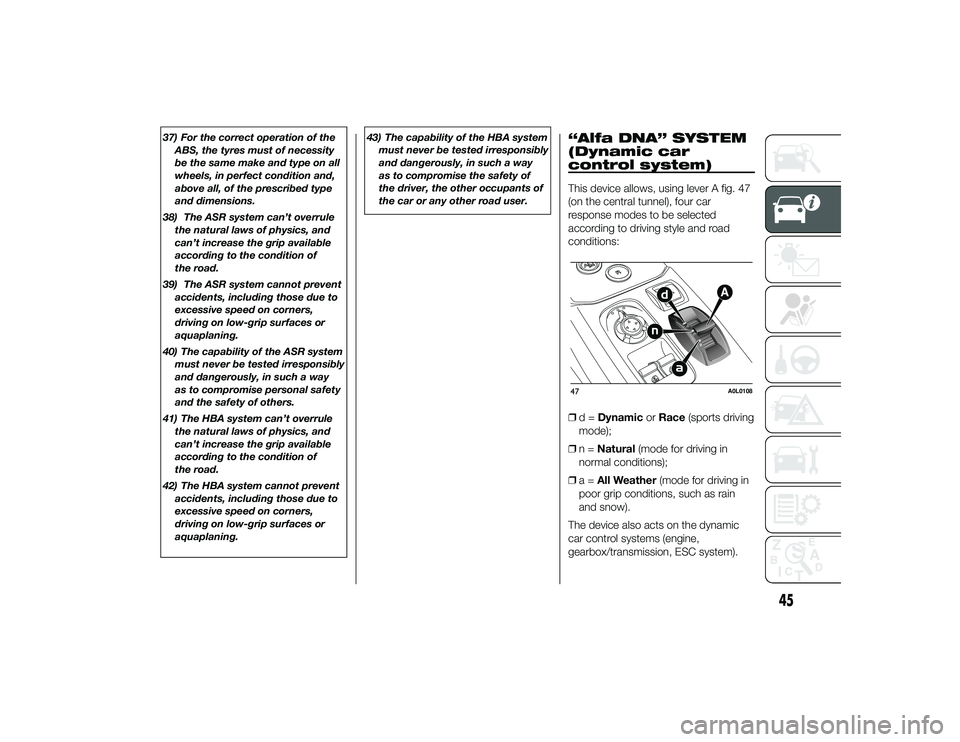
37) For the correct operation of theABS, the tyres must of necessity
be the same make and type on all
wheels, in perfect condition and,
above all, of the prescribed type
and dimensions.
38) The ASR system can’t overrule the natural laws of physics, and
can’t increase the grip available
according to the condition of
the road.
39) The ASR system cannot prevent accidents, including those due to
excessive speed on corners,
driving on low-grip surfaces or
aquaplaning.
40) The capability of the ASR system must never be tested irresponsibly
and dangerously, in such a way
as to compromise personal safety
and the safety of others.
41) The HBA system can’t overrule the natural laws of physics, and
can’t increase the grip available
according to the condition of
the road.
42) The HBA system cannot prevent accidents, including those due to
excessive speed on corners,
driving on low-grip surfaces or
aquaplaning. 43) The capability of the HBA system
must never be tested irresponsibly
and dangerously, in such a way
as to compromise the safety of
the driver, the other occupants of
the car or any other road user.
“Alfa DNA” SYSTEM
(Dynamic car
control system)This device allows, using lever A fig. 47
(on the central tunnel), four car
response modes to be selected
according to driving style and road
conditions:
❒d=Dynamic orRace (sports driving
mode);
❒ n=Natural (mode for driving in
normal conditions);
❒ a=All Weather (mode for driving in
poor grip conditions, such as rain
and snow).
The device also acts on the dynamic
car control systems (engine,
gearbox/transmission, ESC system).47
A0L0108
45
24-9-2013 11:49 Pagina 45
Page 49 of 190
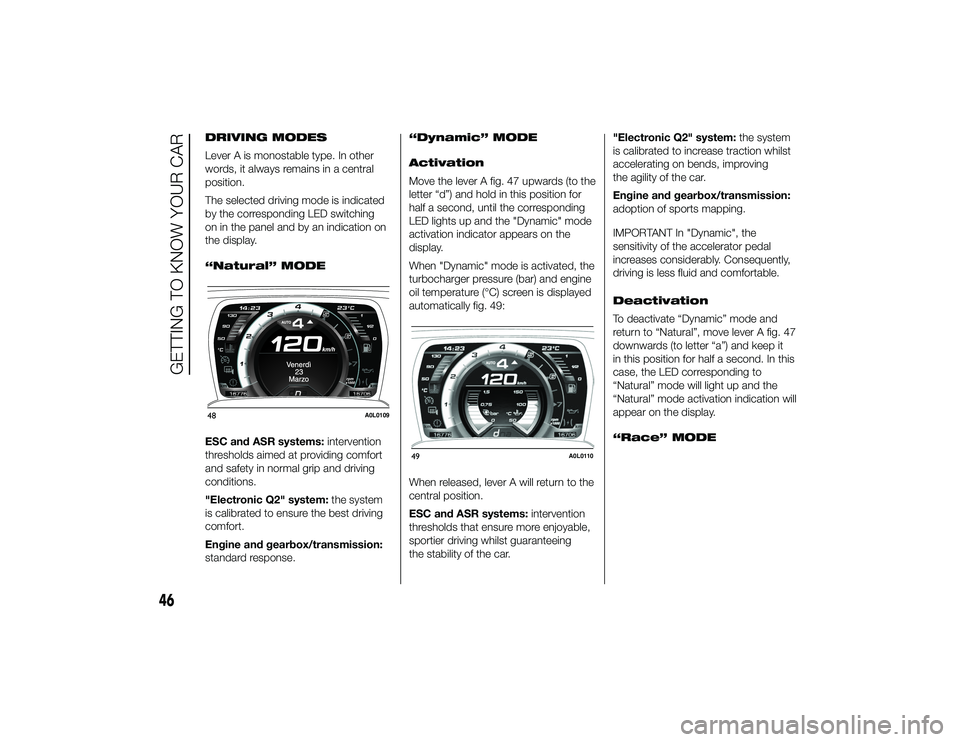
DRIVING MODES
Lever A is monostable type. In other
words, it always remains in a central
position.
The selected driving mode is indicated
by the corresponding LED switching
on in the panel and by an indication on
the display.
“Natural” MODE
ESC and ASR systems:intervention
thresholds aimed at providing comfort
and safety in normal grip and driving
conditions.
"Electronic Q2" system: the system
is calibrated to ensure the best driving
comfort.
Engine and gearbox/transmission:
standard response. “Dynamic” MODE
Activation
Move the lever A fig. 47 upwards (to the
letter “d”) and hold in this position for
half a second, until the corresponding
LED lights up and the "Dynamic" mode
activation indicator appears on the
display.
When "Dynamic" mode is activated, the
turbocharger pressure (bar) and engine
oil temperature (°C) screen is displayed
automatically fig. 49:
When released, lever A will return to the
central position.
ESC and ASR systems:
intervention
thresholds that ensure more enjoyable,
sportier driving whilst guaranteeing
the stability of the car. "Electronic Q2" system:
the system
is calibrated to increase traction whilst
accelerating on bends, improving
the agility of the car.
Engine and gearbox/transmission:
adoption of sports mapping.
IMPORTANT In "Dynamic", the
sensitivity of the accelerator pedal
increases considerably. Consequently,
driving is less fluid and comfortable.
Deactivation
To deactivate “Dynamic” mode and
return to “Natural”, move lever A fig. 47
downwards (to letter “a”) and keep it
in this position for half a second. In this
case, the LED corresponding to
“Natural” mode will light up and the
“Natural” mode activation indication will
appear on the display.
“Race” MODE48
A0L0109
49
A0L0110
46
GETTING TO KNOW YOUR CAR
24-9-2013 11:49 Pagina 46
Page 50 of 190
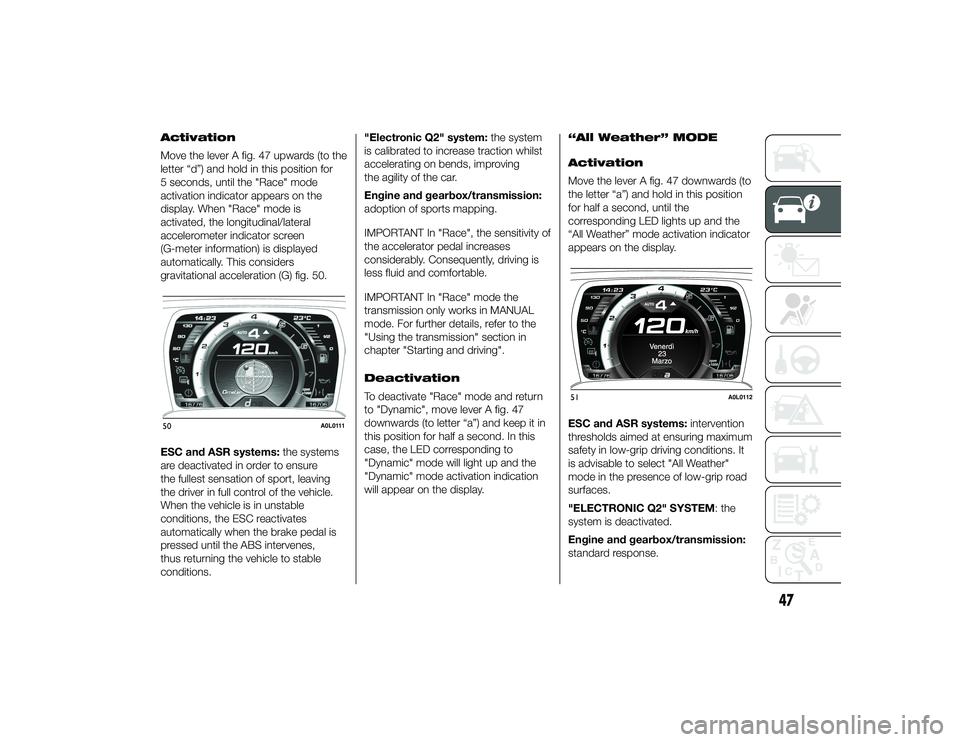
Activation
Move the lever A fig. 47 upwards (to the
letter “d”) and hold in this position for
5 seconds, until the "Race" mode
activation indicator appears on the
display. When "Race" mode is
activated, the longitudinal/lateral
accelerometer indicator screen
(G-meter information) is displayed
automatically. This considers
gravitational acceleration (G) fig. 50.
ESC and ASR systems:the systems
are deactivated in order to ensure
the fullest sensation of sport, leaving
the driver in full control of the vehicle.
When the vehicle is in unstable
conditions, the ESC reactivates
automatically when the brake pedal is
pressed until the ABS intervenes,
thus returning the vehicle to stable
conditions. "Electronic Q2" system:
the system
is calibrated to increase traction whilst
accelerating on bends, improving
the agility of the car.
Engine and gearbox/transmission:
adoption of sports mapping.
IMPORTANT In "Race", the sensitivity of
the accelerator pedal increases
considerably. Consequently, driving is
less fluid and comfortable.
IMPORTANT In "Race" mode the
transmission only works in MANUAL
mode. For further details, refer to the
"Using the transmission" section in
chapter "Starting and driving".
Deactivation
To deactivate "Race" mode and return
to "Dynamic", move lever A fig. 47
downwards (to letter “a”) and keep it in
this position for half a second. In this
case, the LED corresponding to
"Dynamic" mode will light up and the
"Dynamic" mode activation indication
will appear on the display. “All Weather” MODE
Activation
Move the lever A fig. 47 downwards (to
the letter “a”) and hold in this position
for half a second, until the
corresponding LED lights up and the
“All Weather” mode activation indicator
appears on the display.
ESC and ASR systems:
intervention
thresholds aimed at ensuring maximum
safety in low-grip driving conditions. It
is advisable to select "All Weather"
mode in the presence of low-grip road
surfaces.
"ELECTRONIC Q2" SYSTEM: the
system is deactivated.
Engine and gearbox/transmission:
standard response.50
A0L0111
51
A0L0112
47
24-9-2013 11:49 Pagina 47
Page 54 of 190

ACOUSTIC SIGNAL
When reverse gear is engaged and
there is an obstacle behind the vehicle,
an acoustic signal is emitted which
varies according to the distance of the
bumper from the obstacle.
The frequency of the acoustic signal:
❒increases as the distance between
car and obstacle decreases,
culminating in a continuous acoustic
signal, when the distance is less
than approximately 30 cm;
❒ decreases if the distance from the
obstacle increases, until the signal
ceases entirely;
❒ remains constant if the distance
between car and obstacle remains
unchanged; if this situation concerns
the side sensors, the signal will
stop after approximately 3 seconds
to avoid, for example, indications
in the event of manoeuvres along a
wall.
If several obstacles are detected by the
sensors, only the nearest one is
considered. INDICATIONS ON
DISPLAY
(for versions/markets, where provided)
When the sensors are activated, the
screen in fig. 54 appears on the display.
Obstacle presence and distance
information is therefore provided both
by the acoustic signal and the
instrument panel display.
The system indicates a detected
obstacle by displaying an arc in one or
more positions according to the
distance of the obstacle and its position
in relation to the car.
If an obstacle is detected in the rear
central area, the display shows all the
arcs in the rear central area, up to
the one that corresponds to the
position of the obstacle itself.The signal is similar for obstacles in the
rear left or right area.
The arc that corresponds to the
position of the obstacle will flash.
The colour on the display depends on
the distance from and position of the
obstacle.
The car is close to the obstacle when
the display shows a single constant arc
and emits a continuous sound.
If there are several obstacles, the
closest one is indicated.
FAULT INDICATION
Parking sensor failures, if any, will be
indicated when reverse is engaged by
the switching on of the
warning
light on the instrument panel together
with the message on the display (see
“Warning lights and messages”
chapter).
GENERAL WARNINGS
45)4)
When parking, take the utmost care
over obstacles that may be above
or under the sensor.
54
A0L0044
51
24-9-2013 11:49 Pagina 51
Page 55 of 190

Under certain circumstances, objects
close to the vehicle are not detected by
the system and could therefore cause
damage to the car or be damaged
themselves.
Some conditions may influence the
performance of the parking sensors:
❒the presence of ice, snow, mud
or multiple layers of paint on the
sensor surface may cause reduced
sensitivity of the sensor itself and
therefore reduce the system
performance;
❒ mechanical interference (e.g. washing
the car, rain, strong wind, hail) may
cause the sensor to detect a
non-existent obstacle ("echo
interference");
❒ the presence of ultrasonic systems
(e.g. pneumatic brake systems of
trucks or pneumatic drills) near the
car could alter the signals sent by the
sensor;
❒ the variation in sensor position,
caused by variation in ride (due
to suspension component wear),
changing tyres, overloaded car,
or tuning that lowers the car, for
example, may affect parking sensor
system performance.
WARNING
45) The responsibility for parking
and other dangerous manoeuvres
always and in every case lies
with the driver. While carrying out
these manoeuvres, always make
sure that no people (especially
children) or animals are in the
area concerned. The parking
sensors are an aid for the driver,
but must never allow their
attention to lapse during
potentially dangerous
manoeuvres, even those executed
at low speeds.
IMPORTANT
4) The sensor must be free frommud, dirt, snow or ice in order for
the system to operate correctly.
Be careful not to scratch or
damage the sensors while
cleaning them. Avoid using dry,
rough or hard cloths. The sensors
must be washed using clean
water, with the addition of car
shampoo if necessary. When
using special washing equipment
such as high pressure jets or
steam cleaning, clean the sensors
very quickly keeping the jet more
than 10 cm away. Also, do not
apply stickers to the sensors.
52
GETTING TO KNOW YOUR CAR
24-9-2013 11:49 Pagina 52
Page 72 of 190

❒Average speed B
❒ Trip time B (driving time).
“Trip B” may be disabled (see "Trip B
Activation/Data (Trip B enablement)"
paragraph). The “Range” and “Instant
consumption" values cannot be reset.
VALUES DISPLAYED
Range
This indicates the approximate distance
that can still be travelled with the fuel
in the tank, assuming that driving style
remains unvaried.
The display will show the reading “- - -
-” when the following events take place:
❒ range value lower than 50 km (or 30
mi)
❒ car parked with engine running for a
long period.
IMPORTANT The range value variation
can be affected by several factors:
driving style, type of route (motorway,
urban, mountain roads, etc.), conditions
of use (load, tyre pressures, etc.). Trip
planning must therefore take the above
into account. Distance travelled
This value shows the distance covered
from the start of the new journey.
Average consumption
This value shows the approximate
average fuel consumption from the start
of the new journey.
Instant consumption
This value shows the instant fuel
consumption. The value is constantly
updated. The display will show “----”
if the car is parked with the engine
running.
Average speed
This value shows the car's average
speed based on the overall time
elapsed since the start of the new
journey.
Trip time
Time elapsed since the start of the new
journey.
Indications on display
Each time a value is selected, the
following information is shown:
❒
the word “Trip” (or “Trip A” or “Trip B”)
(A fig. 62);
❒ name, value and unit of measure of
the selected value (e.g. "Range 520
km") (B fig. 62).
After a few seconds, the name of the
selected value is replaced by the
corresponding icon (see example fig.
63).
TRIP RESET button
The TRIP RESET button is located on
the right stalk fig. 64. With the ignition
key at MAR-ON, it allows you to view
the values described previously and
also reset them to begin a new journey:
❒ brief press: display various values;
62
A0L0122
69
24-9-2013 11:49 Pagina 69
Page 79 of 190
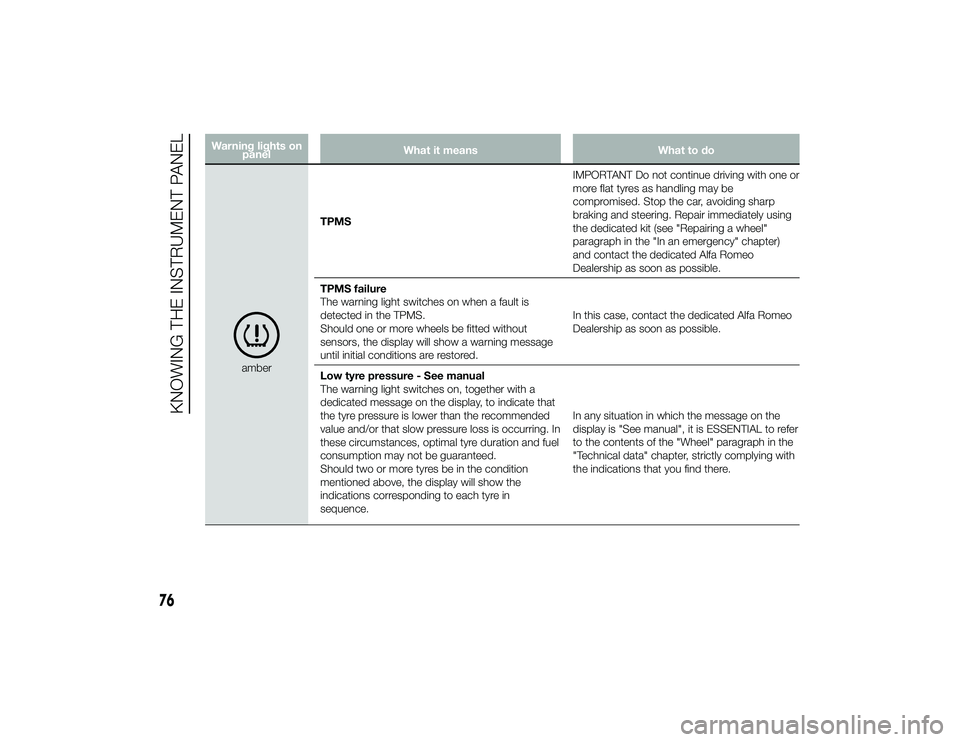
Warning lights onpanel What it means
What to do
amberTPMS
IMPORTANT Do not continue driving with one or
more flat tyres as handling may be
compromised. Stop the car, avoiding sharp
braking and steering. Repair immediately using
the dedicated kit (see "Repairing a wheel"
paragraph in the "In an emergency" chapter)
and contact the dedicated Alfa Romeo
Dealership as soon as possible.
TPMS failure
The warning light switches on when a fault is
detected in the TPMS.
Should one or more wheels be fitted without
sensors, the display will show a warning message
until initial conditions are restored. In this case, contact the dedicated Alfa Romeo
Dealership as soon as possible.
Low tyre pressure - See manual
The warning light switches on, together with a
dedicated message on the display, to indicate that
the tyre pressure is lower than the recommended
value and/or that slow pressure loss is occurring. In
these circumstances, optimal tyre duration and fuel
consumption may not be guaranteed.
Should two or more tyres be in the condition
mentioned above, the display will show the
indications corresponding to each tyre in
sequence. In any situation in which the message on the
display is "See manual", it is ESSENTIAL to refer
to the contents of the "Wheel" paragraph in the
"Technical data" chapter, strictly complying with
the indications that you find there.
76
KNOWING THE INSTRUMENT PANEL
24-9-2013 11:49 Pagina 76
Page 80 of 190

Warning lights onpanel What it means
What to do
amberELECTRONIC STABILITY CONTROL (ESC)
SYSTEM
When the ignition key is turned to MAR-ON, the
warning light switches on, but should switch off
as soon as the engine is started.
Intervention by the system is indicated by the
flashing of the warning light: it indicates that the
car is in critical stability and grip conditions.
If the warning light does not switch off, or if it
stays on with the engine running, ESC system
malfunction has been detected.
Contact the dedicated Alfa Romeo Dealership as
soon as possible to have the problem diagnosed
and resolved.
Hill Holder failure
The warning light switches on together with the
digital warning light and corresponding
message on the display to indicate Hill Holder
system failure. In this case, contact the dedicated Alfa Romeo
Dealership as soon as possible.
amberASR FUNCTION DEACTIVATED WARNING
LIGHT
When the ignition key is turned to MAR-ON, the
warning light switches on, but should switch off
as soon as the engine is started.
The
warning light switches on when the ASR
function of the electronic stability control (ESC)
system is deactivated (by selecting "Race" mode).
When the ASR function is reactivated, the
warning light switches off.
77
24-9-2013 11:49 Pagina 77